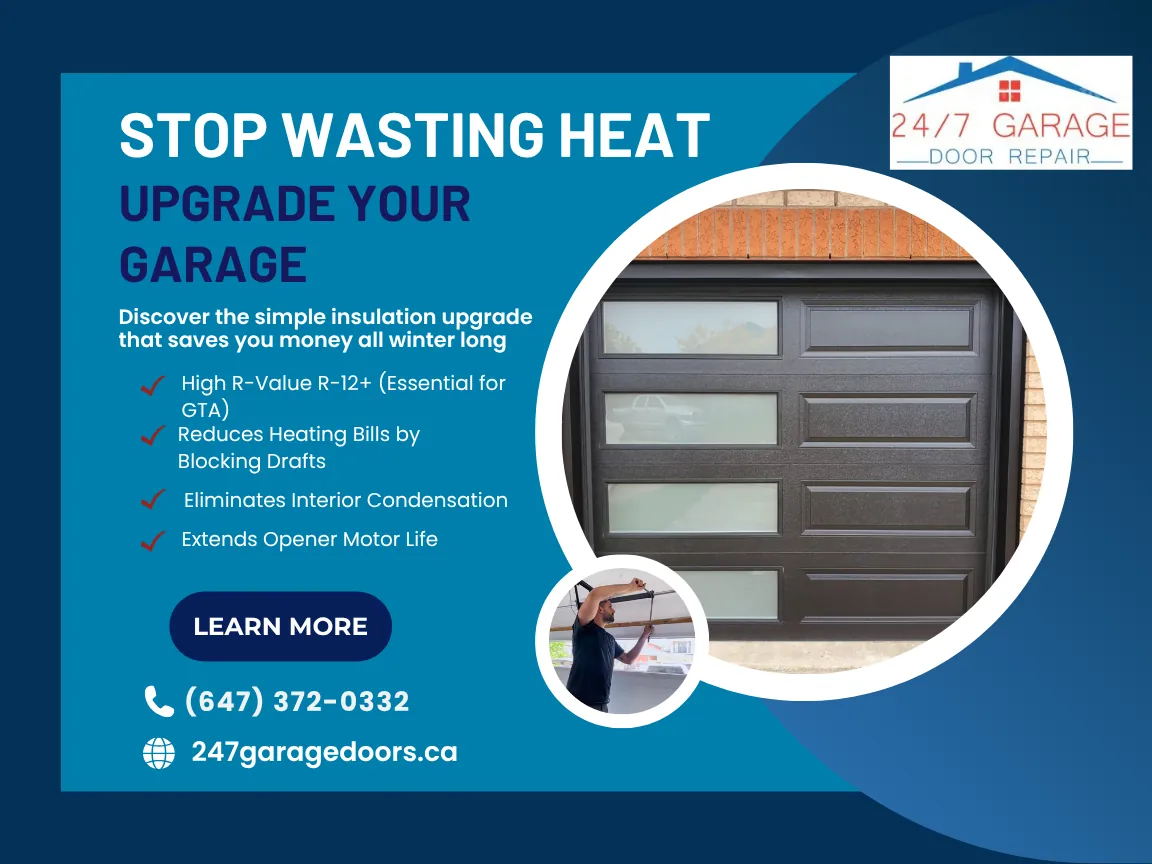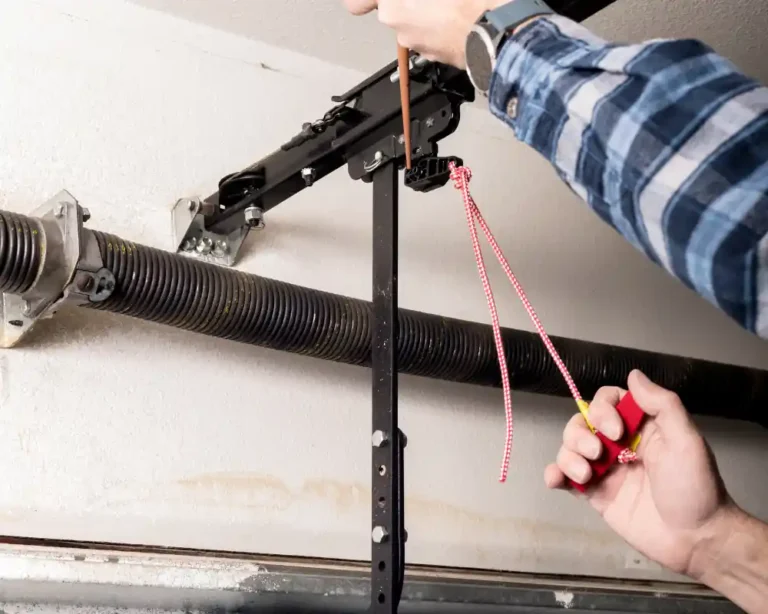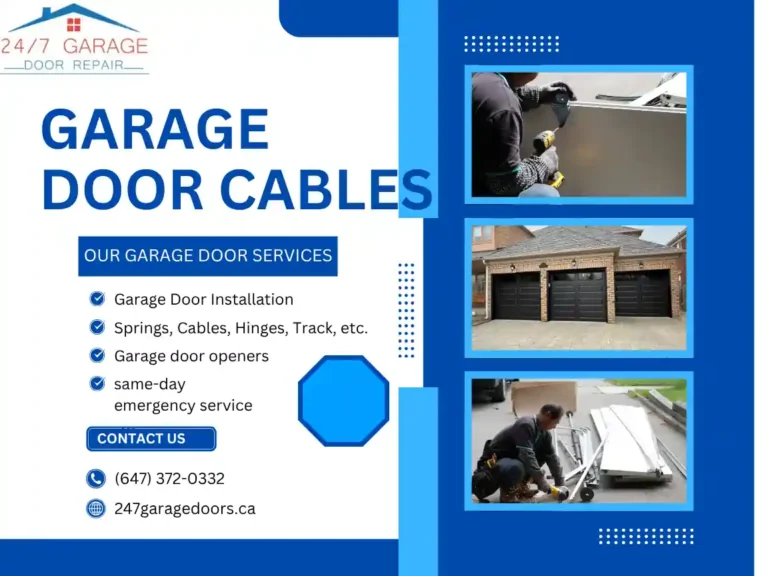The garage door, often the largest moving fixture on your home, is also one of the biggest sources of energy loss. For homeowners in the GTA, where winter temperatures drop severely (often to -7°C or colder), choosing an Energy-efficient garage door is not a luxury—it’s a mandatory upgrade for comfort, reduced utility bills, and structural protection.
This comprehensive guide delivers eight amazing facts about Energy-efficient garage doors, detailing the science behind high R-Value insulation, explaining the difference between foam cores, and providing actionable tips on weather seal protection. By understanding these facts, you can make a smart investment that pays dividends for the life of your home.


Fact 1: The R-Value is Everything (Especially in Canada)
The R-Value is the measure of a material’s resistance to heat flow. The higher the number, the better the door is at insulating your garage and keeping interior temperatures stable. This fact is paramount to Energy-efficient garage doors.
The Amazing Fact: While an uninsulated garage door has an R-Value near 0, modern insulated garage door R-value options range from R-9 to R-18.
- Recommendation: For an attached garage in the Greater Toronto Area, an R-Value of R-12 or higher is strongly recommended to minimize heat loss and protect the adjacent living space from the cold.
- The Science: Insulation prevents conductive heat transfer. This means less heat escapes from your home’s forced air system into the garage, reducing strain on your furnace and lowering your annual energy consumption. For more context on why R-values are crucial in the Canadian climate, consult Natural Resources Canada’s guidelines on insulation standards.
Fact 2: Polyurethane is the King of High R-Value Insulation
Not all foam insulation is created equal. The type of core material used in Energy-efficient garage doors drastically affects the R-Value and the structural integrity.
The Amazing Fact: Polyurethane insulation is twice as effective as polystyrene (Styrofoam) insulation per inch of thickness.
- Polyurethane (PUR): This liquid foam is injected and expands to fill the entire space between the steel skins. It creates a dense, rigid foam that bonds to the metal panels, yielding R-Values up to R-18 and adding structural strength and quiet operation.
- Polystyrene (EPS): This is a budget-friendly option where sheets of foam are simply inserted between the door panels. While it’s better than nothing, it leaves small gaps and does not provide the same structural reinforcement.
| Insulation Type | R-Value (per inch) | Density & Strength | Primary Benefit |
| Polyurethane (PUR) | R-6 to R-7.5 | High (Bonds to door) | Maximum thermal efficiency, noise reduction. |
| Polystyrene (EPS) | R-3 to R-5 | Low (Inserted sheets) | Affordability, basic temperature control. |
Fact 3: The Thermal Break Eliminates Heat Loss Points
Insulation is useless if cold air can transfer through the material holding the insulation together. This is where the concept of the thermal break comes in.
The Amazing Fact: Energy-efficient garage doors feature a thermal break—a section of non-conductive material (often wood or composite blocks) that separates the interior steel skin of the door from the exterior steel skin.
- The Problem Solved: Without a thermal break, the steel acts as a conduit, allowing cold to pass from the outside surface to the inside surface, creating a cold spot and fostering interior condensation. A thermal break stops this cold transfer at the joint. For detailed construction information, refer to industry leaders like Garaga Insulated Doors.
- Weather Seal Protection: Look for doors that integrate thermal breaks at the joints between sections (Interlok™ systems), as noted by manufacturers like Garaga (Source 5.4).
Fact 4: Weather Seals are Your Last Line of Defense
Gaps around the door are a major source of air leakage, regardless of the insulated garage door R-value.
The Amazing Fact: High-quality perimeter seals and thermal door seals can be more important than the insulation itself in preventing drafts.
- Types: Look for thermal door seals like double-blade vinyl weatherstripping for the frame and bulb-type rubber seals for the bottom. These materials remain flexible even in sub-zero temperatures (down to -52°C), ensuring a continuous, airtight seal against the Canadian elements. For tips on caulking and sealing best practices, consult reliable resources like DAP Canada’s guides.
- Moisture Control: Effective weather seals block wind, rain, and snow, preventing the buildup of moisture that can lead to freezing and structural damage.
Fact 5: Energy Efficiency is Key to Home Value (ROI)
An Energy-efficient garage door is one of the highest-value home improvements you can make.
The Amazing Fact: Replacing an outdated garage door often provides one of the highest returns on investment (ROI) compared to other home renovations. A new door signals quality, energy consciousness, and long-term savings to prospective buyers.
- The Investment: While a quality double-insulated door costs between $2,800 and $5,000+ CAD installed, the resulting energy savings and boost in curb appeal can make it a net positive investment over time. This makes it a smart investment garage door for any homeowner.
Fact 6: The Garage Protects Your Furnace and Water Heater
For homes with attached garages, the garage temperature directly affects the efficiency and longevity of utilities stored there.
The Amazing Fact: An insulated door protects your mechanical equipment.
- Utilities: If your water heater or furnace is located in the garage, the stable temperature provided by an Energy-efficient garage door helps these units operate more efficiently and prevents cold stress on pipes, reducing the risk of freezing.
- Adjacent Rooms: If you have a room above the garage, insulation is mandatory to maintain comfort and prevent that room from becoming an unlivable space in the winter.
- Opener Longevity: An insulated door is better balanced, reducing the strain on your Garage Door Opener Repair motor, thus extending its lifespan.
Fact 7: Professional Installation Preserves the R-Value
A high insulated garage door R-value means nothing if the installation is faulty. Poor sealing can negate all the benefits of the door’s construction.
The Amazing Fact: Choosing professional Garage Door Installation is the only way to guarantee your door’s R-Value is preserved.
- Airtight Seal: Professionals ensure the door is perfectly plumb, square, and sealed with continuous caulking and flashing. This prevents air infiltration, which is where most energy is lost.
- System Integration: The installation includes proper spring tensioning to ensure the opener can handle the added weight of the insulation without premature wear, guaranteeing long-term operation. For information on comparing door materials and their benefits, see the analysis from Clopay Door Insulation.
Fact 8: Rebates and Incentives Reward Efficiency
Homeowners in Canada often have access to government programs that offset the cost of Energy-efficient garage doors.
The Amazing Fact: Programs like the Canada Greener Homes Grant provide incentives for major home upgrades that meet high energy performance standards. While garage doors must be part of a larger energy retrofit plan, investing in high R-Value insulation can help you qualify for substantial rebates. Check local and federal programs for eligibility before purchasing. For a visual reference on insulation standards, consult the Home Depot R-Value Chart.
Service & Upgrade Cost (CAD)
| Component/Service | Estimated Cost Range (CAD) | Key Function/Energy Benefit |
| Insulated Double Door (R-12 to R-18) | $2,800 – $5,000+ | Reduces heat transfer by up to 90% (High R-Value). |
| Polyurethane Insulation Upgrade | +$300 – $700 | Adds structural strength and the highest R-Value insulation. |
| Thermal Door Seals & Weatherstripping | $100 – $250 (Professional Install) | Blocks air leakage (drafts) around the door perimeter. |
| Full Professional Installation Labor | $350 – $700 | Ensures airtight seal to preserve R-Value and guarantees system balance. |
Conclusion: Make the Smart Investment in Energy-Efficient Garage Doors
An Energy-efficient garage door is a foundational upgrade for any home in the GTA. By prioritizing high R-Value insulation like polyurethane, demanding quality thermal door seals, and ensuring professional garage door installation, you make a smart investment garage door that delivers year-round comfort and verifiable savings on your utility bills.
Don’t let your garage be an energy drain. For expert advice on selecting the best insulated garage door for your home’s specific needs, visit our website on Full Garage Door Replacement service for more details. You can also Contact Us today to book your consultation.










